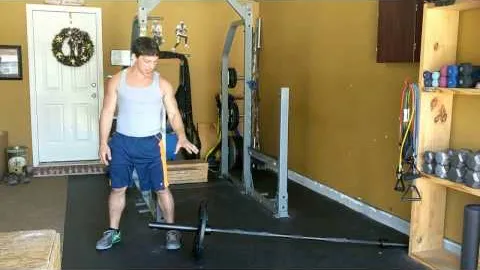
If you're looking to develop strong, well-rounded shoulders and improve your posture, then the Landmine Rear Deltoid Row exercise is a must-try. This exercise targets the posterior deltoids, which are the muscles responsible for the movement of your shoulders and upper back. Incorporating this exercise into your workout routine can help you achieve a more balanced and proportionate upper body.
Setup: To begin, place one end of a barbell into a landmine attachment or a sturdy anchor point. Stand facing the barbell with your feet shoulder-width apart. Engage your core and keep a slight bend in your knees for stability.
Grip: With an overhand grip, reach down and grasp the weighted end of the barbell using both hands. Keep your arms fully extended and your palms facing your body.
Starting Position: Stand tall, maintaining a straight and upright posture. Your shoulders should be relaxed, and your back should be slightly arched. This is your starting position.
Execution: Lift the barbell by pulling your elbows up and back, squeezing your shoulder blades together. Focus on using your rear deltoids to perform the movement. Keep your elbows close to your body and avoid leaning forward or backward. Continue to lift until the barbell is near your upper abdomen.
Squeeze: Pause for a moment at the top of the movement and squeeze your rear deltoids. This will help to maximize muscle activation.
Lowering: Slowly lower the barbell back to the starting position, maintaining control throughout the descent. Repeat for the desired number of repetitions.
Incorporating the Landmine Rear Deltoid Row into your workout routine offers several benefits:
The Landmine Rear Deltoid Row specifically targets your rear deltoids, helping to strengthen and develop this often neglected muscle group. By dedicating attention to the rear delts, you can create a well-balanced and aesthetically pleasing shoulder development.
Many people tend to have rounded shoulders or a forward head posture due to poor posture habits or spending extended periods in a seated position. The Landmine Rear Deltoid Row can help correct these imbalances by strengthening the muscles responsible for pulling the shoulders back and promoting proper alignment.
Strong rear deltoids contribute to improved upper body functionality. Whether you're involved in sports, gym workouts, or daily activities, having a strong posterior deltoid muscle group allows for better shoulder stabilization, increased pulling strength, and enhanced overall performance.
To get the most out of your Landmine Rear Deltoid Row, keep these tips in mind:
Including the Landmine Rear Deltoid Row in your workout routine can bring about significant improvements in shoulder strength, posture, and overall upper body functionality. By dedicating attention to the often-neglected rear deltoids, you can build well-rounded shoulders and improve your physique. Remember to start with lighter weights, focus on proper form, and gradually increase the intensity as you become more comfortable with the exercise. Give this exercise a try and watch as your shoulders become stronger, and your posture improves!
If you're looking for a gym, fitness club or yoga studio, you've come to the right place.
You can find information about gyms in your area. Browse catalog of gyms and find gyms with classes which are you looking for.
On gym page you can find simple information like address, phone or website. You can find list of available classes. You can check availability of personal training or small group classes. On place page you can also see information about open hours.
You can find gyms near you with amenities, courts, studios and equipments.
Use our map to find gym at your city or district.
In Gym Navigator you can find list of exercises with movies for many body parts.
You can browse exercises catalog and find exercises the best of you.
You can also find exercises grouped into workout plans, which you can use to improve you body. Each routine show you exercises one by one and give you possibility to count you progress and count down rest time.